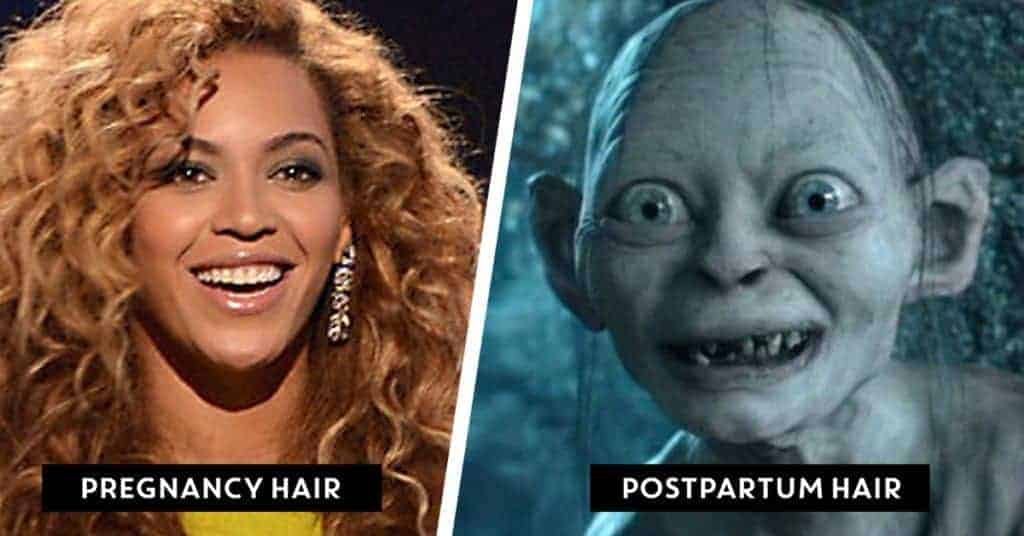Let’s talk postpartum hair loss.
Pregnancy may have given you a thick, beautiful head of hair that made even the messiest of mom buns look ‘gramable, but thanks to a big old shift in postpartum hormones, effortless good hair days may soon be a thing of the past.
We all know pregnancy changes e-v-e-r-y-t-h-i-n-g, and your hair is no different. Thanks to increased estrogen, the natural cycle that dictates hair growth shifts, giving you fuller, thicker locks. Huzzah! But, since life isn’t fair, that extra hair flees the scene soon after you’ve delivered your baby.
Why Postpartum Hair Loss Happens
Normally, 85-95% of your hair is in the active growth stage, while 5-15% of your hair is resting before it falls out. When you get pregnant, all that extra estrogen prolongs the growth stage, keeping more hair on your head for longer, hence the thicker hair.
In the postpartum hormone dump, more than the normal 5-15% of hair follicles enter the resting cycle, which basically means you shed like a mo’ fo’.
This stage can feel alarming at best, and absolutely terrifying at worse. It looks like SO. MUCH. HAIR. and, as your shower drain can attest, it is. But before you schedule your appointment for hair plugs, remember that in most cases, this is normal, and eventually it will grow back.
Typically the hair loss peaks around 5 months, and by 1 year, your hair is starting to resemble its previous, pre-pregnancy glory.
Can It Be Stopped?
There’s nothing you can do to prevent the Great Follicular Exodus of _______ (insert child’s birth year), but if you have hair skills, you can cover it up or use products that help fake the look of luxurious locks. For me, it was always the regrowth stage that was most awkward, with wingalings sprouting from my crown that left me looking like a kindergartener that got a little too frisky with the scissors.
When Postpartum Hair Loss Isn’t Normal
In some cases, excessive hair loss can be an indicator of two conditions, anemia and postpartum thyroiditis, but a conversation with your healthcare provider can help determine if further diagnostics are needed.
Tips and Tricks for Coping with Hair Loss
Here are some recommendations from readers:
Use volumizing shampoos and conditioners
Choose shampoo and conditioner that won’t weigh your hair down, and won’t clog up your hair follicles. When you condition, focus more of the product on the ends of your hair, not on your scalp. If you’re really freaking out and don’t mind something more spendy, try Nioxin shampoo and conditioner, which come in different numbered “systems” depending on your hair type. Nioxin leaves your head kinda tingly, which is neat and makes you feel like maybe something is happening.
Use volume styling products
To amp up wispy or flat hair, use styling products specifically for adding volume. Spray mousse onto roots, blow-dry your hair upside down, and lock the volume into place with a lightweight spray. Random wispy hairs sticking straight up off your scalp, mocking your attempts to look like you have your crap together? Spray a little hairspray on your palms and gently smooth those little bastards down.
Style strategically
If you have thin spots that show when you put your hair in a ponytail or bun, keep the pony or bun loose, not scraped back tight. With any hairstyle, you can disguise thin spots by tapping eyebrow powder onto your scalp with an angled eyeshadow brush. For the most natural look, choose a color that is close to or slightly darker than your roots, and keep the powder a tiny bit back from your actual hairline. If you’re not sure if there are thin spots showing on the crown of your head or on the back of your head, ask a six-year-old to take a look. They will absolutely tell you the truth.
Cover and protect
Now’s a great time to get in the habit of wearing a hat if you’re going to be out in the sun at all. Normally your hair probably does a decent job of keeping your scalp in the shade. But if you’ve got some thin spots, you really have to protect that skin. There are some leave-in conditioners with spf, but they mostly leave your hair pretty greasy, which isn’t a great look. Hats are convenient, hide the fact that maybe you didn’t shower today, and set a good example of sun safety for your kids.
In summary
While postpartum hair loss is totally normal, it's not fun and can be alarming. Depending on how thick and voluminous your hair was to begin with often dictates how noticeable it is when it decides to depart. Thankfully, it's temporary and you won't have to endure the Count Chocula look for very long.
Related: Happily After Giving Birth – 10 Things They Don’t Tell You




Leave a Comment